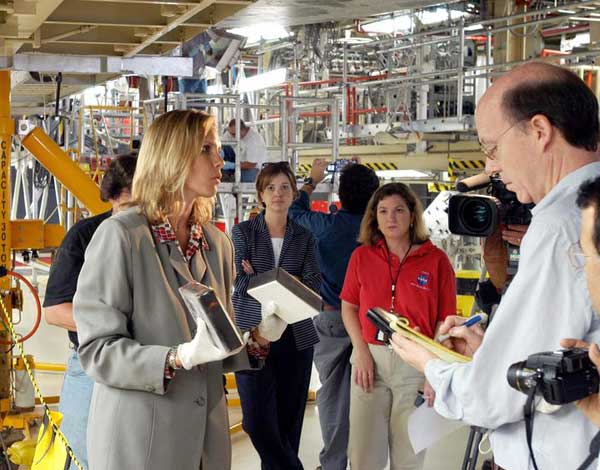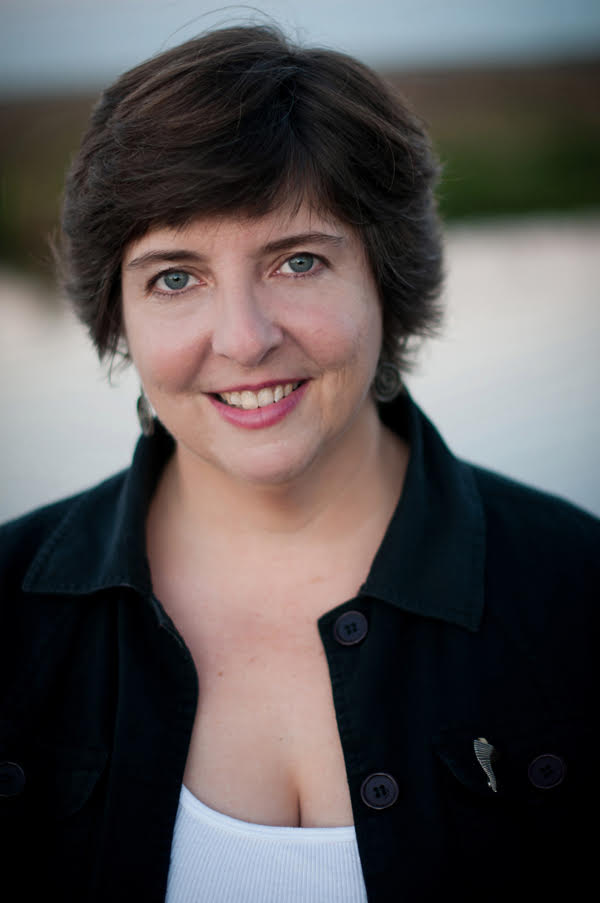Shuttle Shuffle: Discovery Gets the Call

This story is Chapter 4 in an 11-part series by Florida Today.
COCOA - Stephanie Stilson'scell phone rang as she listened to her college class on another phone. She wasworking to get her master's degree in business, and the University of Floridateleconference was part of her online course.
She skipped a meeting at workso she wouldn't miss her virtual class. But as the NASA manager responsible forshuttle Discovery, she finds that work follows her home.
It was February 2004. She-- and everyone else -- looked forward to seeing Atlantis return the fleet tospace. Stilson was about to find out otherwise.
She answered the cellphone.
"Well," saidScott Thurston, her equivalent on the Atlantis team, "you're it!"
It wasn't a good day forThurston, but he was good-humored about it. Inspectors found improperlyinstalled gears in Atlantis' braking system. They found the same problem inDiscovery, but it would take longer to get Atlantis ready.
Get the Space.com Newsletter
Breaking space news, the latest updates on rocket launches, skywatching events and more!
Discovery would lead NASA'sshuttles back to space. And Stilson -- used to juggling school, work, softball,her pets and the rest of her life -- would lead Discovery.
"Wow, this is going tobe really neat," she thought.
She didn't realize whatDiscovery's move to the front of the line meant for her.
"At that time, I'mjust still processing the orbiter, getting ready to fly," she said."I don't have any idea of all the things that are going to happen, thediscussions I'm going to be a part of."
Stilson had shepherdedDiscovery through flight preparations twice before. It was nothing like this:more talk, more meetings, more debates, more modifications, more newsreporters.
There were days when shegot frustrated; for instance, every time a management decision added work tothe flow. But her team, and her spirit, carried her through.
"I work with so manygreat people that everyone takes responsibility for what their part is init," she said, "and you know, in all reality, I have a very smallpart, because there are so many people that are doing the hard work. . . . Theyall make my job easy."
FORT MYERS: Passion forspace started early in life
Stilson's energy, optimismand leadership emerged early. Born in Georgia, she grew up in Fort Myers, theoldest of six kids, a perfectionist and a role model.
"She's theleader," father John Stilson said. "She's the one that sets the tonefor everybody else."
When she was 8 or 9, shewas able to program a complicated game into a Commodore 64 computer. During avisit to Kennedy Space Center, she told her dad she wanted to be an astronaut.She had a cutout solar system strung across her ceiling. "She loved thespace program," he said.
Together, she, her fatherand one of her brothers took an astronomy course at Edison Community Collegewhen she was about 10. They were the class darlings, passing with great marks.In the stars, John Stilson saw the signs of where Stephanie was headed.
She was determined andaggressive. Always a good athlete, she specialized in softball. In basketball,she couldn't be stopped.
"Her temperament is, Ithink, a lot like mine," John Stilson said. "I don't think she evermade it through a full game without fouling out."
She studied computer andelectrical engineering at North Carolina State University and, while in school,applied to work at NASA. There were no openings. She started looking elsewhere,then got a surprise offer to work at Kennedy Space Center.
Once she graduated, sheworked full time on Spacelab, a laboratory that sits inside the shuttles' cargobays. Then, she moved to power systems for the International Space Station.
She wanted to work on theshuttles. She didn't see how they could be as complex as the station payloads,which are different for every mission.
"They're justprocessing the same vehicle every time," she and her friends working onthe space station used to say. "It can't be that difficult."
Then she started working onthe shuttle as Discovery's manager. She found out why everything took so long.It's complicated. It's old. She learned to respect it, and fast.
"There's never a timewhere everything's just OK," said Stilson, 35. "There's alwayssomething that comes up that you've got to go either figure out, investigate,determine whether you need to replace it, or figure out if you need to doadditional testing."
COCOA: Relaxing oasisoffers a break from Discovery
Stilson's home in westCocoa is an oasis, a place to relax after the stresses of work.
On a large lot rich inpalmettos and larger trees, she and roommate Shannon Logan can let the two dogsrun. There's Scrappy Lou, a feisty Boston terrier who got a C in obedienceclass. And there's Santa's Little Helper, a pug puppy named for the dog on"The Simpsons." Stilson also has a cat named Snowball, another nameborrowed from the show.
One evening in her yard,the two dogs, both females, grappled for a stick, even though there were plentyto choose from.
They, and everything elseabout the place, seem to match Stilson's personality: boundlessly energetic,friendly, with a sense of adventure, an appreciation of nature.
The yard, with its fire pitand trees wrapped with strings of lights, is perfect for parties, like the oneshe has on New Year's Eve.
On the second-floor deck,Stilson can aim her telescope skyward.
Feeders attract a varietyof birds; she has spotted painted buntings there, a big deal for birders. It'sa hobby she picked up from her former in-laws. She plans vacations aroundplaces where she can spy new species for her list.
The garage houses her twocool cars: a 1966 Mustang in Tahoe Turquoise and a 2002 Thunderbird in a nearlyidentical color.
And just inside the frontdoor is a framed poster of rocker Melissa Etheridge, facing away from thecamera, a guitar slung over her bare back. "It sends such a message of howyou can be tough but still feminine," Stilson said.
KENNEDY SPACE CENTER:Short delays keep manager on her toes
"She's an up-and-comer,"said shuttle program manager Bill Parsons, who once had Stilson's job atKennedy Space Center. "She is one of the bright stars that we have outhere."
When you see people likethat, Parsons said, you just want to remove any barriers in their way. But therestill are many to overcome.
Every morning while theorbiter is in the garage, Stilson runs an early meeting in a narrow, windowlessroom with light-gray walls and dark-gray carpet, a refrigerator and a TV. Thetopic is schedules: When will everything get done? How will they knit sevendays of work, three shifts apiece, into one seamless flow when so many tasksare dependent upon another?
People drink coffee andPepsi and talk about glitches and plans. Stilson forgoes caffeine but paysclose attention, asking questions to make sure everyone's on track.
The Columbia AccidentInvestigation Board found that schedule pressure led managers to compromisesafety. Even if NASA says it's not schedule-driven now, someone has to lay downa timeline and try to meet it. The buck stops at KSC and, in the case of thismission, with Stilson.
In a work flow this long,what the shuttle types call a major modification period, it's important to havedeadlines, Stilson said.
"New things creep upevery day," she said. "So for us to sit back and say, 'Oh, we've gotextra time now,' it doesn't work that way. It really doesn't. We have to keeplooking at our near-term milestones and hold those, because we never knowwhat's around the next corner that may be a big hitter that would cause us togo back to the program and say, 'We're in trouble.' "
After the accident, peopleacross the agency saw a chance to re-evaluate everything, not just the areashighlighted by the Columbia investigators. Stilson's team had to put the piecestogether. There were refurbished panels and new sensor wiring for the wings,and an extension to the robot arm to inspect the ship's heat shield in orbit.There were problems with flex hoses, leaky thrusters, reversed gears in thebrakes, landing-gear door seals.
Short delay after shortdelay piled onto the big delay after repeated hurricanes closed KSC.
Stilson's biggest concernwasn't any one thing. It was the constantly mounting little things.
"As we don't makethose targets, everything gets pushed out and pushed out and pushed out,"she said, "and myself and my contractor counterpart (with United SpaceAlliance), we're very close to that, and we know that even though it looks justlike a little thing, when you keep pushing it out, it creates this bow wave at theend."
Publishedunder license from FLORIDATODAY. Copyright ? 2005 FLORIDA TODAY. No portion of this materialmay be reproduced in any way without the written consent of FLORIDA TODAY.
Florida Today Special Report: NASA's Return to Shuttle Flight
Fixing NASA: Complete Coverage ofSpace Shuttle Return to Flight
Join our Space Forums to keep talking space on the latest missions, night sky and more! And if you have a news tip, correction or comment, let us know at: community@space.com.

Chris Kridler is a writer, editor, photographer and storm chaser who authored a group of storm-chasing adventure novels called Storm Seekers. As a reporter covering space, her subjects have included space shuttle missions, the Mars Rovers from California’s Jet Propulsion Lab, and a Soyuz launch and mission from Kazakhstan and Russia. Much of that work was published through her longtime column at Florida Today. Her photographs have been featured in magazines and books, including the covers of The Journal of Meteorology, the book Winderful, and the Wallace and Hobbs Atmospheric Science textbook. She has also been featured in Popular Photography. Kridler started chasing tornadoes in 1997, and continues the adventure every spring in Tornado Alley.









